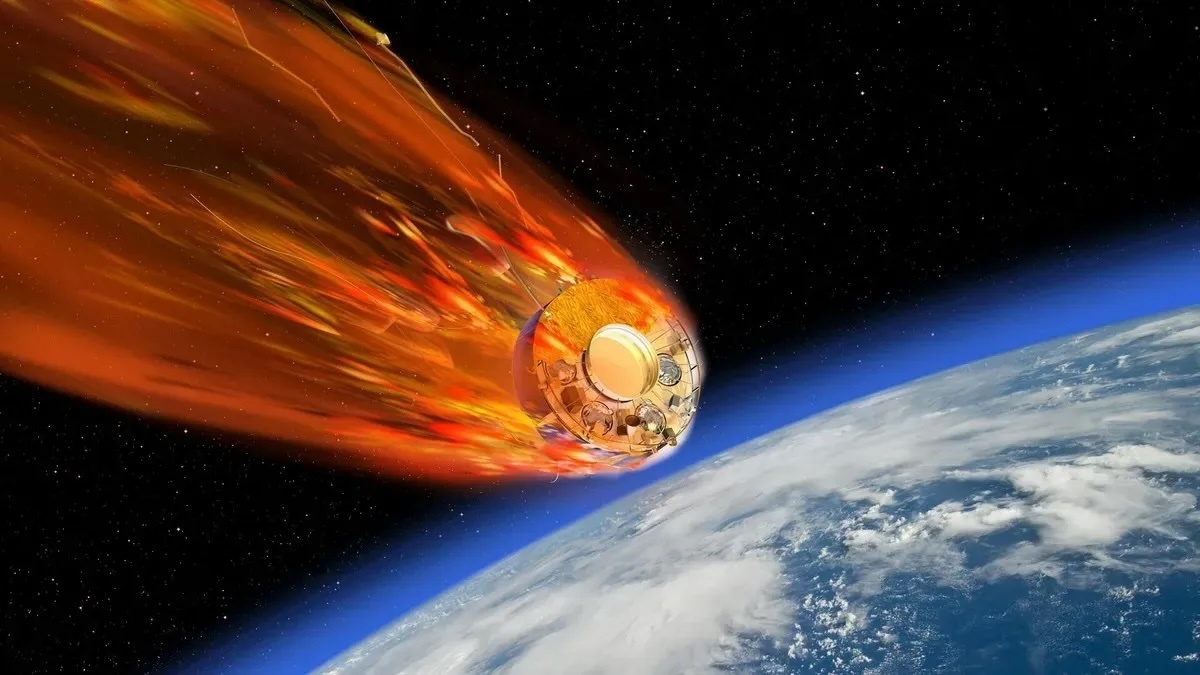4.06.2025
"Everything we have ever designed to go into space has been one mission, one life. It's sort of crazy."

Artist's illustration of a satellite — in this case, the European Space Agency's Salsa Cluster spacecraft — burning up during reentry to Earth's atmosphere. (Image credit: ESA/David Ducross)
The world at large is working to stop the fast-progressing degradation of Earth's environment. In the space sector, however, one-use-only products still reign supreme. The advent of megaconstellations has, in fact, accelerated the rate at which the space industry burns through resources, shifting from big satellites with decades-long lifespans to cheaper birds designed to expire within a few short years.
The disposable approach worries some researchers, as too much aluminum is burning up in the atmosphere these days, threatening to cause a new kind of environmental disaster in the decades to come. But what can we do? Should we roll back the space revolution and put a cap on what we can do in space? Or could a circular economy, life extension, recycling and reuse be the solution to the space industry's dirty side effects?
Proponents of in-orbit servicing and refueling laud the technology's potential. But most analysts remain cautious: Without strict environmental regulations, the expected cost of in-orbit servicing may not entice satellite operators to switch to reusable technology en masse.
Dave Barnhart, chief executive officer of the California-based aerospace company Arkysis, first began developing concepts of recyclable satellite technology some 15 years ago as part of a project he oversaw at DARPA (the Defense Advanced Research Projects Agency). He and his colleagues investigated how to set up a satellite recycling facility in geostationary orbit — the region about 22,000 miles (36,000 kilometers) above Earth's surface where satellites appear fixed above one spot above the equator.
"We wanted to know whether we can use parts from old geo satellites to recreate new ones, because the mass is already there," Barnhart told Space.com.
The geostationary ring is home to some of the largest and most expensive satellites. On top of that, the long distance between Earth and this orbit makes geo missions inherently costly, as they require the most powerful rockets with a lot of fuel to reach their destination.
Yet, Arkysis, the company Barnhart cofounded in 2015, is focusing on low Earth orbit (LEO) — the buzzing region closest to Earth up to altitudes of about 1,200 miles (2,000 km). Arkysis hopes to set up an in-orbit servicing and refueling depot called the Port in LEO. The main goal is to spearhead a green revolution in this region, which gives rise to thousands of tons of dangerous space debrisevery year.
In 2023, Arkysis secured a $1.6 million deal from the U.S. Space Force to test satellite assembly in orbit using the Port demo module — a basic building block of a scalable orbiting garage and gas station. The company wants to launch the first component of this orbital depot next year — a last-mile transportation device called the Cutter, which is designed to help satellites to dock with the garage.
In 2027, the main Port module, a hexagonal structure about 9 feet (3 meters) wide, will join the Cutter in orbit to test how the mechanical interfaces of the two work together in space. The Port, in addition to serving as a fuel depot, will arrive with a supply of components and payloads that could be attached to worn-out satellites to give them a new lease on life.
"Today, everything on a satellite is done on the ground, and the satellite is launched with an end date," Barnhart said. "We want to shift that to allow extensions of both — life and business — post-launch. We want to be able to add new revenue streams post-launch. You can do that if you can add something, change something in orbit, or even sell that satellite to somebody else who could make it part of a larger platform."
Cameras or antennas could be replaced with more powerful ones once those get developed, worn-out batteries could be swapped for brand-new ones, and fuel tanks would get refilled.
It all makes sense on paper, but Dafni Christodoulopoulou, space industry analyst at the consultancy company Analysis Mason, warns that whether satellite operators would be inclined to ditch their disposable ways will come down to the cost of the in-orbit maintenance services. LEO is currently dominated by small, relatively cheap satellites, she says, which can be replaced more cheaply than they can be serviced and maintained.
"Right now, we expect in-orbit services to come at a cost that might be quite high for operators of small satellites," Christodoulopoulou told Space.com. "The operators might not be interested in those services, because the price of building a new satellite might not be higher than that of a servicing mission."
Barnhart agrees that the fledgling in-orbit servicing industry is likely to face resistance not just from operators but also from satellite manufacturers, who might feel threatened by the idea of reusability and life extension.
"Every time you want to make a big shift like this, it's going to be a threat," Barnhart said. "Satellite manufacturers make money by building more satellites to throw away. It might take some time for them to see that by fitting satellites with interfaces that allow them to be serviced, they could actually add some cool functionality to them after launch."
Still, Christodoulopoulou thinks that in-orbit servicing will eventually make a difference to how things are done in space, and also to the state of the orbital environment.
"The number of satellite launches is not expected to go down, so there will be a high need for constellation management, flexibility, disposal and life extension," she said. "I think in-orbit services can definitely help prevent the buildup of space debris and maintain long-term sustainability in orbit."
The U.S. government certainly appears to think that life extension is the way forward. In addition to funding the Arkysis experiment, the Space Force also funds the Tetra-5 and Tetra-6 missions to test in-orbit refuelling technologies in space. The two missions, designed to test hardware developed by Orbit Fab, Astroscale and Northrop Grumman, are set to launch in 2026 and 2027, respectively.
In addition, intensifying geopolitical tensions are increasing the need for quick deployment of new systems in space, which, Barnhart says, could be more speedily addressed with servicing systems such as the Port, than by building new spacecraft from scratch on Earth.
"If there is a new threat that has been identified, you might need a new type of sensor or a new payload to observe it," Barnhart said. "If we can augment the satellites that the government has already put up and provide them with a new capability, a new sensor, we can address those threats much faster."
Christodoulopoulou thinks that new regulations designed to protect the environment and curb the air pollution related to satellite reentries could further help move the needle toward a less throwaway culture in space utilization.
"There need to be a few changes," Christodoulopoulou said. "There needs to be more awareness among satellite operators to understand that in-orbit servicing offers a value in the long term. But also on the government side, there need to be more regulations to support the in-orbit servicing providers."
Quelle: SC
